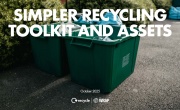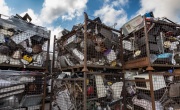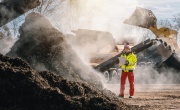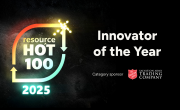Waking up to the alarm of Covid-19
As the Covid-19 pandemic continues, Peter Maddox, WRAP Director, states we must look to the future and make the circular economy our new normal, promoting planetary and public health in the aftermath of the crisis
For me, if there’s one word that sums up the Covid-19 pandemic, it’s ‘alarm’. I’ve found the enforced changes to daily life – for me, my family and my work colleagues – to be quite alarming. The impact of this terrible virus on families certainly alarms me, as do the risks endured by our wonderful NHS and care home staff and other essential workers, including those in the resources and waste sector. Stepping back, our current situation is clearly an alarm call to us all, a warning that when this is all over, we can’t just go back to ‘business as usual’.

The current situation offers us a real chance to re-imagine and to develop a world that uses the planet’s precious resources more sustainably and – ultimately – build a new type of economy that is more resilient, in ways it is not now. It’s reasonable to assume we may eventually suffer other unforeseen and disruptive events so, despite what we are going through now, we need to have an eye on the future. It’s clear now, if it wasn’t before, that people’s health is fundamentally linked to the planet’s health.
Think about the efforts to secure sufficient vital personal protection equipment (PPE). It emphasises how fragile global markets and supply chains can be, especially if we rely on our ‘just in time’ economic model. What if a future event threatened food supplies? We saw at the start of the scare here in the UK how shelves were suddenly cleared and manufacturers and retailers struggled to replace essential stocks quickly enough. Any new approach must start with resilience to such events as a key goal. This means more of a ‘just in case’ economic model driven by local and regional thinking as much as national and international. Ultimately, we must find a greater appreciation of the value of the materials and resources we take, use and dispose.
A circular economy (CE) would certainly help and those who make policy are increasingly embracing it. CE underpins the UK Government’s 2018 Resources and Waste Strategy and most of its other environmental policy initiatives, such as the 25 Year Environment Plan, the net-zero commitment and the clean growth and industrial strategies.
Consider one type of material in demand during the current crisis: fibre packaging. On the one hand, we’re using even more of it because so many goods are being ordered online and delivered to our ‘locked-down’ homes. Prices for recovered board are good as paper manufacturers seek supplies of recycled cardboard as never before. But business collections are down because the retail outlets and the many businesses that usually generate this waste stream are generally shut down. That is not a resilient system. Instead, we must consider more circular approaches to replace single-use packaging like this with return schemes that emphasise greater reusability through smarter design.
We know that, as well as preserving vital resources, moving to a more circular economy will also help us respond to another consequence of Covid-19: a likely increase in unemployment. A more circular economy creates net jobs. This particular benefit was the conclusion of a joint WRAP and Green Alliance report published in 2015 – ‘Employment and the circular economy’. It found that a real commitment to CE could create over half a million jobs and reduce unemployment by over 100,000 by 2030. Our economy has taken a big hit from Covid-19. If, as is likely, we have to tackle higher unemployment then, five years after the report, there’s still every reason why a circular approach makes a lot of sense, even if the exact numbers will be different now.
Indeed, it was heartening to see, just a few days ago, that a study from the University of Oxford, co-authored by such heavyweight economists as Sir Nicholas Stern (author of the highly influential Stern Review on the Economics of Climate Change back in 2006) and Nobel Prize winner Joseph Stiglitz, concluded that environmental stimulus packages would be a more effective way of repairing global economies than traditional government spending. The lead author told the Guardian: “Tackling climate change has the answer to our economic problems.” And we know that moving to a CE can help address the climate emergency.
We all have to look into the future with new eyes. In the past, businesses have resisted changing their business models for more circular ones because of a perceived risk. It was hard to confront their ‘if it ain’t broke, why fix it?’ argument. I don’t believe that will still hold true when we escape the clutches of Covid-19. Existing business models have been tested to destruction by the virus. As businesses rebuild, they should take the opportunity to reimagine their business as a circular one. They will be pleasantly surprised that it would make them more resilient to another unexpected shock. WRAP piloted many examples of circular business models as part of the EU-funded REBus project a few years back, so case studies are available.
What alarms me is that the environmental agenda may be forgotten amidst efforts to ‘get the economy back on its feet.’ But if the pandemic has proved anything, it’s that the existing model of the economy is not fit for purpose. It needs replacing with a more resilient alternative. I hope that we use this crisis to embrace the opportunities of a more circular economy, and ensure that whatever the ‘new normal’ is, we do not end up with a ‘new similar’.






